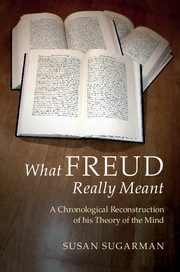Book contents
- Frontmatter
- Dedication
- Contents
- Acknowledgments
- Introduction
- 1 Freud on psychoanalysis: Five Lectures on Psychoanalysis (1909a)
- 2 The pleasure and reality principles: “Formulations regarding two principles in mental functioning” (1911); “The psychology of the dream-processes” from The Interpretation of Dreams” (1900)
- 3 Ambivalence and the origin of the civilized mind: “Taboo and emotional ambivalence” from Totem and Taboo (1913b)
- 4 Narcissism as a stage in development: “On narcissism: an introduction” (1914)
- 5 The impetus to the mind: “Instincts and their vicissitudes” (1915a)
- 6 The possibility of repression: “Repression” (1915b); “Negation” (1925a)
- 7 The unconscious and the structure of the mind: “The unconscious” (1915c)
- 8 Beyond the pleasure principle: Beyond the Pleasure Principle (1920)
- 9 A new architecture of the mind: The Ego and the Id (1923)
- 10 Pleasure revised: “An economic problem in masochism” (1924)
- 11 Civilization, morality, and the pursuit of pleasure: Civilization and its Discontents (1930)
- Epilogue: What Freud really meant
- References
- Index
1 - Freud on psychoanalysis: Five Lectures on Psychoanalysis (1909a)
Published online by Cambridge University Press: 05 April 2016
- Frontmatter
- Dedication
- Contents
- Acknowledgments
- Introduction
- 1 Freud on psychoanalysis: Five Lectures on Psychoanalysis (1909a)
- 2 The pleasure and reality principles: “Formulations regarding two principles in mental functioning” (1911); “The psychology of the dream-processes” from The Interpretation of Dreams” (1900)
- 3 Ambivalence and the origin of the civilized mind: “Taboo and emotional ambivalence” from Totem and Taboo (1913b)
- 4 Narcissism as a stage in development: “On narcissism: an introduction” (1914)
- 5 The impetus to the mind: “Instincts and their vicissitudes” (1915a)
- 6 The possibility of repression: “Repression” (1915b); “Negation” (1925a)
- 7 The unconscious and the structure of the mind: “The unconscious” (1915c)
- 8 Beyond the pleasure principle: Beyond the Pleasure Principle (1920)
- 9 A new architecture of the mind: The Ego and the Id (1923)
- 10 Pleasure revised: “An economic problem in masochism” (1924)
- 11 Civilization, morality, and the pursuit of pleasure: Civilization and its Discontents (1930)
- Epilogue: What Freud really meant
- References
- Index
Summary
The task is … to discover, in respect to a senseless idea and a pointless action, the past situation in which the idea was justified and the action served a purpose.
– S. Freud, Introductory Lectures on Psychoanalysis, p. 270.Freud, trained as a medical doctor, turned to psychology after studying treatment of the neurotic disorder hysteria with the French neurologist Jean-Martin Charcot. In the 1890s he collaborated with Viennese physician Josef Breuer in an early improvisation on what would become psychoanalytic treatment of that disorder – one in which patients exhibited behavioral symptoms ranging from tics to severe paralysis, all without organic basis.
His theory originated in that experience and remained accountable to his clinical observations thereafter. In 1909, by invitation of the president of Clark University in Massachusetts, Freud presented some of those observations to a predominantly lay audience. His addresses, published as Five Lectures on Psychoanalysis, engage both theory and therapy; their ongoing synergy would drive Freud's contribution then and going forward.
Freud makes the critical point in that slender work that psychopathological symptoms, like more evidently rational behavior, have a sense. They are determined, by which he means they follow coherently from some premise in the person's mind. They serve a purpose. Thus, the human mind, and even the diseased human mind, as Freud conceives it, is not a mad, seething cauldron; it has integrity and structure.
After grounding his conception in an illustration of psychopathology, Freud calls for and proposes a psychological explanation of mental illness. Then, drawing on his clinical experience, he outlines techniques of psychoanalytic therapy through which he found it possible to uncover the source of individual ailments and cure them. Next he describes a general etiology of disorder that has resulted from his efforts, which brings him to a discussion of what he calls the sexual function and its place in human development. He concludes with an extrapolation to the nature of psychological health.
THE SENSE OF SYMPTOMS AND THEIR IMPLICATIONS FOR UNCONSCIOUS MENTATION
In his first lecture, Freud discusses a case of hysteria treated by Breuer and draws from its symptoms and treatment a justification of the existence of unconscious mentation. Before Breuer, hysterias, labeled as such by the medical establishment in keeping with the ancient Greek designation, were held to be associated with previous emotional shock and were largely dismissed.
- Type
- Chapter
- Information
- What Freud Really MeantA Chronological Reconstruction of his Theory of the Mind, pp. 4 - 14Publisher: Cambridge University PressPrint publication year: 2016



